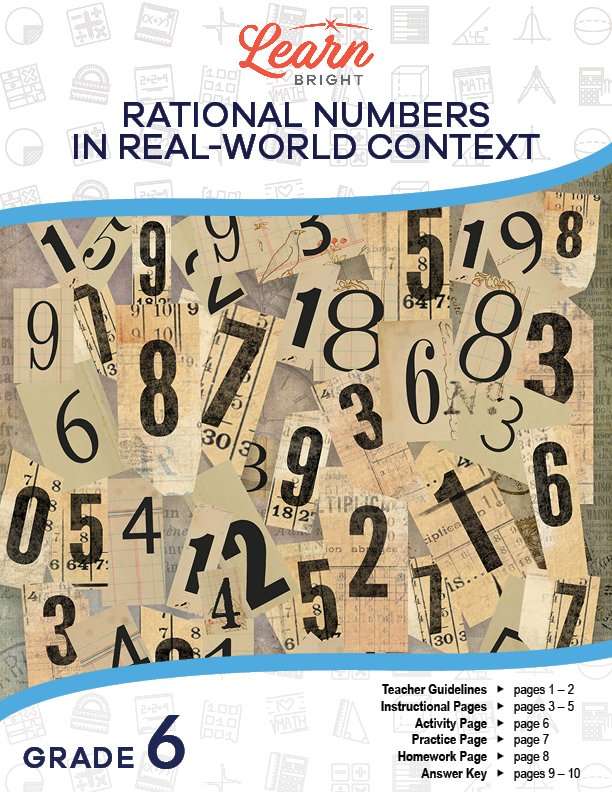Description
What our Rational Numbers in Real-World Context lesson plan includes
Lesson Objectives and Overview: Rational Numbers in Real-World Context teaches students how to work with rational numbers in real-world situations. At the end of the lesson, students will be able to write, interpret, and explain statements of order for rational numbers in real-world contexts. This lesson is for students in 6th grade.
Classroom Procedure
Every lesson plan provides you with a classroom procedure page that outlines a step-by-step guide to follow. You do not have to follow the guide exactly. The guide helps you organize the lesson and details when to hand out worksheets. It also lists information in the blue box that you might find useful. You will find the lesson objectives, state standards, and number of class sessions the lesson should take to complete in this area. In addition, it describes the supplies you will need as well as what and how you need to prepare beforehand.
Options for Lesson
Included with this lesson is an “Options for Lesson” section that lists a number of suggestions for activities to add to the lesson or substitutions for the ones already in the lesson. One optional adjustment to the lesson activity is to provide your students with the information for the activity table so that less class time is used. You can also have your students create fictitious data rather than look it up online.
Teacher Notes
The teacher notes page includes a paragraph with additional guidelines and things to think about as you begin to plan your lesson. This page also includes lines that you can use to add your own notes as you’re preparing for this lesson.
RATIONAL NUMBERS IN REAL-WORLD CONTEXT LESSON PLAN CONTENT PAGES
Rational Numbers in Real-World Context
The Rational Numbers in Real-World Context lesson plan includes three content pages. Rational numbers in a real-world context means that you are looking at how you use numbers in everyday life to help solve problems.
People all over the world use math every single day. A farmer might try to figure out how many crops they can plant in one field compared to another. Someone might search for the lowest cell phone price for their new family plan. You might count your allowance to see how much you have earned and spent. All of these examples compare positive and negative numbers to each other, and all of these people are trying to figure out which has more or less. These are statements of inequality.
When comparing numbers, you use three symbols: = (equal to), > (greater than), and < (less than). It’s very easy to compare numbers when you’re looking at a number line. The numbers get smaller as you move left and larger as you move right.
Example 1
Let’s take a look at an example. You have two investment properties. The first one is a house and you have a profit of $150 each month. The second one is a condo and you have a loss of $50 each month.
Remember that losses are negative and profits are positive. You can compare the numbers 150 and -50 easily using a number line. First, mark each digit on your number line. Next, look at the placement of the numbers.
You can make two statements about the relationship between the numbers. Both are correct! First, you can see that -50 is to the left of 150. Since numbers to the left are smaller, -50 is smaller than 150. Therefore, -50 < 150. Second, 150 is to the right of -50. Numbers to the right are larger, so 150 is larger than -50. Therefore, 150 > -50.
Example 2
Let’s take a look at another example. In the military you have two minutes to do as many push-ups as you can. If you are between the ages of 17 and 21, the average number is 35. Recruit #1 scores a +4 and Recruit #2 scores -3. How can we compare these numbers?
You can compare the numbers 4 and -3 using a number line. First, mark each digit on the number line. Next, look at the placement of the numbers.
Like with the first example, you can make two correct statements about the relationship between the numbers. First, you can see that -3 is to the left of 4. Since numbers to the left are smaller, -3 is smaller than 4. Therefore, -3 < 4. Second, 4 is to the right of -3. Numbers to the right are larger, so 4 is larger than -3. Therefore, 4 > -3.
There are many different ways to compare numbers. You think about and compare numbers every day without thinking about it. However, you were actually making statements about inequalities with rational numbers!
RATIONAL NUMBERS IN REAL-WORLD CONTEXT LESSON PLAN WORKSHEETS
The Rational Numbers in Real-World Context lesson plan includes three worksheets: an activity worksheet, a practice worksheet, and a homework assignment. You can refer to the guide on the classroom procedure page to determine when to hand out each worksheet.
CREATING A TABLE ACTIVITY WORKSHEET
For the activity worksheet, students will choose a topic and create a table with six values. Their tables will contain three positive and three negative integers. Students will then write three inequality statements about their tables both algebraically and verbally. Finally, they will decorate their tables or add images.
PUTT-PUTT PRACTICE WORKSHEET
The practice worksheet asks students to solve a word problem about four friends playing putt-putt golf. They will use the provided chart of scores to plot points on number lines and write algebraic and verbal inequalities.
RATIONAL NUMBERS IN REAL-WORLD CONTEXT HOMEWORK ASSIGNMENT
The homework assignment asks students to solve a word problem about drivers in school zones. They will use the provided chart of cars and driving speeds to plot points on number lines and write algebraic and verbal inequalities.
Worksheet Answer Keys
This lesson plan includes answer keys for the practice worksheet and the homework assignment. If you choose to administer the lesson pages to your students via PDF, you will need to save a new file that omits these pages. Otherwise, you can simply print out the applicable pages and keep these as reference for yourself when grading assignments.









